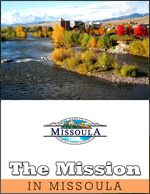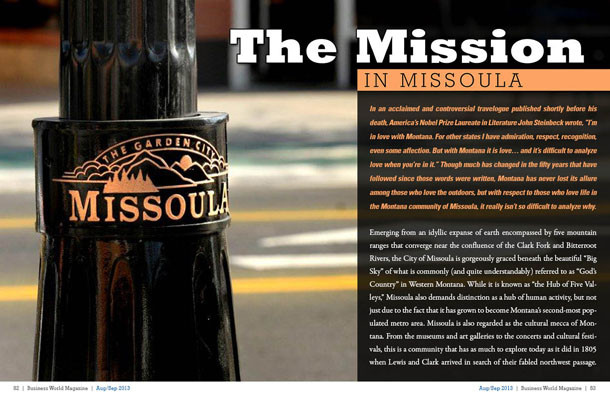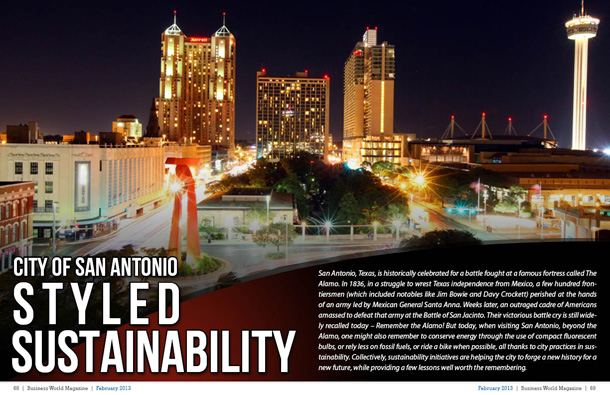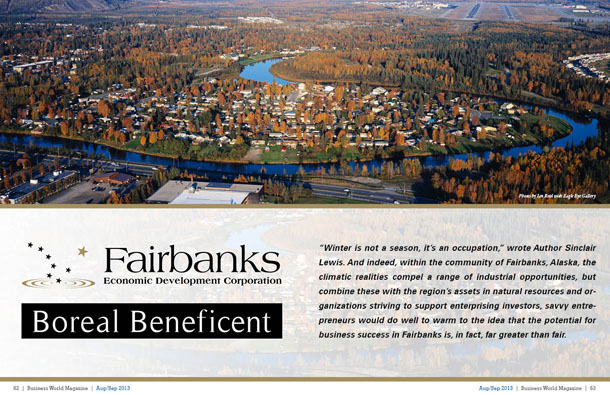Â

In an acclaimed and controversial travelogue published shortly before his death, America’s Nobel Prize Laureate in Literature John Steinbeck wrote, “I’m in love with Montana. For other states I have admiration, respect, recognition, even some affection. But with Montana it is love… and it’s difficult to analyze love when you’re in it.†Though much has changed in the fifty years that have followed since those words were written, Montana has never lost its allure among those who love the outdoors, but with respect to those who love life in the Montana community of Missoula, it really isn’t so difficult to analyze why.
Emerging from an idyllic expanse of earth encompassed by five mountain ranges that converge near the confluence of the Clark Fork and Bitterroot Rivers, the City of Missoula is gorgeously graced beneath the beautiful “Big Sky†of what is commonly (and quite understandably) referred to as “God’s Country†in Western Montana. While it is known as “the Hub of Five Valleys,†Missoula also demands distinction as a hub of human activity, but not just due to the fact that it has grown to become Montana’s second-most populated metro area. Missoula is also regarded as the cultural mecca of Montana. From the museums and art galleries to the concerts and cultural festivals, this is a community that has as much to explore today as it did in 1805 when Lewis and Clark arrived in search of their fabled northwest passage. The names of these explorers have since been attached to everything from streets and trails to real estate offices and elementary schools, but today, the community is more likely to foster exploration from those seeking educational opportunities. The nearby University of Montana (the state’s oldest institution of higher learning) offers award-winning academics as well as up-close encounters with Grizzlies that are only ravenous when it comes to their want to win and are far less wild than some of their fans. In addition to its recognition as one of America’s Best College Towns, it also brews over with benefits as one of America’s best in beer cities. The mastery of Kettlehouse Brewing Company, Big Sky Brewery and Bayern Brewing (the Rocky’s Mountains only German Brewery) each add to Missoula’s acclaim among beer lovers. Yet by and large, Missoula has also been recognized as simply one of America’s best places to live and its median family income is among the highest in the state. Regardless of the quality of life that affords, the advantages here are incalculable when it comes to opportunities to enjoy the great outdoors. From America’s best mountain biking to trail hiking and river kayaking, Missoula is a nature-lovers paradise that has even been promoted by National Geographic as one of the best places to live for outdoor adventurists. And though this city simultaneously holds title as a national hotspot for hippies, everyone here understands that the real flower power in Missoula isn’t a byproduct of the arts or Avant-garde gatherings, but rather that found interspersed among the hills, the waterways and elevated atmosphere that sustains all.
Sustainability is not as much a new idea as an accepted element of life in Missoula, to such a degree that the community is crowned with further acclaim as one of America’s best in terms of being green. According to Sperling’s study of “Best Green Places,†an analysis of 24 metrics in categories involving air and watershed quality, mass transit usage, power usage, farmers markets & organic food production and green-certified buildings, Missoula has secured rank among the greatest of green metropolitan areas in America.
The Green Scene
Missoula Mayor John Engen is not only determined to keep a green hue to local happenings, but is part of a team dedicated to transitioning Missoula to an even greater shade of green. In this case, advances in energy conservation not only pose benefits in environmental conditions, but also help compel advances in economic development.
“We don’t believe economical development and sustainability practices are mutually exclusive. They go hand in hand. Why would you want to do business in a horrible place? Why would you invest your resources or want to raise a family somewhere that doesn’t offer a decent quality of life?†asks Mayor Engen. “There’s a reason that people find comfort in mountain towns like Missoula. We thrive on being a place where people still say ‘Hi’ when passing someone on the street … a place where people can walk out the back door of their home and participate with nature on a rigorous mountain bike ride or a scooter along a trail… a place with clean water and clean air, a place where professionals acknowledge that sustainability is essential to both the quality and sustainability of their business operations as well as their workforce. The notion that sustainability is somehow separate from economic development is what our City Attorney would describe as ‘poppycock’,†says Engen with conviction.
As Mayor of Missoula since 2006, Engen has helped galvanize local forces in support of the “Best Places Project,†a proposal to create an economic development program based on the recruitment, retention and development of “right-fit†business enterprises. This initiative ultimately helped create what is now known as the Missoula Economic Partnership, an organization funded by both private and public dollars whose services not only involve attracting new business to Missoula, but improving opportunities for those already established here. To advance workforce housing needs, the Mayor’s Office and City Council have also worked on resolutions that have led to affordable housing solutions. Outdated zoning regulations have been updated or reformed to better comply with modern realities in Missoula. While these initiatives respond to the needs of business and the increasing number of people finding their way to Missoula, the formula here does not allow for forsaking of the green spaces for which Missoula is so famed. Working together with the County, the City has enacted policies to conserve and protect an unprecedented amount of acreage both in and around Missoula. Today, in addition to the 400 acres of parklands and 22 miles of trails, there are some 5,000 acres of open space conservation land, and no doubt, the elk and mule deer graze here with an appreciation as fervent as that within those fortunate enough to witness nature’s beauty in Missoula.
From Hellgate to Haven
For all the advancements that are now adding quality to life in Missoula, there was a time when the environmental picture wasn’t so finely focused. To put that in proper perspective, it is necessary to delve back to an era when mining and timber operations accounted for so much of the life here. Long before it gained prominence as a city, this area was simply considered an extension of the Washington Territory, until a small settlement known as the Hellgate Trading Post was established in 1860. This trading post grew along with a proliferation of mill operations that supported the increasing encroachment of Western settlers, and over the century of comings-and-goings that followed, lumbering continued to comprise the lion’s share of economic activities here. In fact, this would become the site of the headquarters for the U.S. Forest Service. While the large scale processing of timber lefts scars on the terrain, the sheer number of smoke stacks took a toll on air quality.
Mayor Engen recalls that as a young boy growing up in Missoula, he participated in one of the early studies involving air quality, a process that required him and other students to take turns breathing into a tube. Analysts were ultimately trying to determine the extent to which people’s lungs were polluted. As Engen says, “It was one thing to always smell the smoke in the air, but you could feel it burning in your lungs too.â€
Area waterways were also impacted by mining operations, especially after the Clark Fork River became the site of a hydro-dam installation. That infrastructure eventually deteriorated and engineers began to worry the mass of sediments that had built-up from mining processes over the years would wreak certain havoc should the dam ever collapse. Ironically, Missoula’s very name stems from the Native American expression by which tribes historically referred to the Clark Fork River (nmesuletk) which translates to “place of frozen water.†In the modern era, frozen water took on a whole new meaning. Engen says this once vibrant waterway and watershed was used historically as a dumping ground for mining sediments upriver and household garbage in Missoula. Eventually, environmental conditions became so serious the site was designated among the most urgent in need of clean-up as indicated by the national Superfund program.
Engen says that era reflects a grim chapter of Missoula’s history “when people turned their back to responsibility.†Yet, that’s certainly not the final chapter in the story of the transformation underway in Missoula. The area around the Clark Fork River was not only cleaned-up a few years ago, but the flow of water restored when the dam was removed in 2008, water flowing freely for the first in more than a century.
“We recognize problems, but look for solutions,†says Mayor Engen. “The Clark Fork River is a good example of how we’ve reformed. The Clark Fork River today is a place where people gather to have picnics with their families, or to go fish, or just to enjoy being outdoors… it has been a great success.â€
Sustaining Success
There is much more that speaks to successful sustainability practices in Missoula. Investment in municipal infrastructure now helps the city ensure its sewer and storm water discharge is as temperate as possible. Mayor Engen’s office has also built upon work underway before he was elected, helping to advance the goals of community coalitions striving to find solutions to mitigate the impact of climate change. As he explains, “We had to acknowledge climate change was real … and we assembled a group of concerned citizens to help us determine what we could do today to make a difference tomorrow.â€
Those deliberations have since resulted in beneficial differences for a number of lives, says City of Missoula Energy Conservation Coordinator Chase Jones. For example, through the auspices of the federal Energy Efficiency and Conservation Block Grant program, Missoula created a program called “Green Blocks.â€
The program prospered through a partnership with NorthWestern Energy which helped provide for professional energy audits on residences in two-block increments throughout Missoula. After the audits were completed, NorthWestern Energy assisted homeowners by providing energy-saving items that included weather-stripping for exterior doors, foam sealants for gaps, programmable thermostats, insulation for hot water heaters and low-flow water savers – and in many cases, attic, wall and basement insulation too. In the pilot phase of the program, Green Blocks’ homes earned an average of $1,500 in energy efficiency upgrades just for participating. In terms of water conservation, a partnership with Mountain Water Company accommodated water-wise audits for participants, which, in turn, led to the installation of water-saving resources whenever such was deemed prudent. The Green Blocks Conservation Side Orders program expanded on this campaign to provide both education and resources to help homeowners further realize practices that prompt increased energy efficiency. In this case, “Side Orders†allowed for a menu of options, pairing homeowners with the appropriate local businesses or non-profit agency that specialized in the required aspect of energy conservation and sustainability. “We thought it would be wise to invest some money in helping people save money,†explains Mayor Engen. “If we did nothing else, but help better insulate their homes, it would still make a difference.†More than 300 homes participated in the audits and some households have achieved monthly savings of $100 off their former heating bills, enabling them to utilize those funds for other needs. As Engen says, “We’re saving energy, but we’re saving dignity in other cases because having an extra $100 per month can make the difference in buying food, or medicine, or paying down on some other bill.â€
The audits and weatherization upgrades have ultimately helped save more than 122,000 kilowatt hours of electricity annually. The City also partnered with industry leader Johnson Controls to identify further savings which could be realized by improvements in municipal infrastructure. As for future plans, Chase Jones indicates that a variety of improvements are in the works, from lighting and building retrofits at City facilities and water conservation projects at many of Missoula’s Park and Recreation sites, to the incorporation of more hybrid-electrical vehicles into city fleet, and more. “We’ll be able to fund many projects through the savings we achieve through energy and water conservation,†says Jones.
Among other notable projects, the City recently cut the ribbon on a new parking garage which Jones says not only provides a huge beneficial function for local businesses, but also makes a statement about the community’s commitment to renewable energy. Missoula contracted with Montana-based solar energy company Sunelco to install a solar array on the roof of this parking facility. The solar array is the largest installation in the state and produces some 85 kilowatts of energy.
Carbon emissions continue to be offset through the lands protected through Missoula’s Open Space program as well as initiatives that promote the use of mass transit, carpooling and biking. Prior to taking his current position with the City, Jones helped coordinate the City program Missoula in Motion (MIM), an organization dedicated to the promotion of sustainable transportation. MIM’s “Way To Go Club!†is comprised today of more than 3,500 members who have pledged to avoid non-single vehicle occupancy during commutes or utilize mass transit systems or bikes. The model has helped eliminate traffic on area roadways as well as exhaust emissions which further helps improve air quality. Another program called “Momentum†strives to achieve similar commitments by working with local companies to improve commuting habits and craft custom rewards programs for their respective employees.
In another project, the City is leasing more than 130 acres of land adjacent to its Waste-water Treatment Plant where a hybrid variety of poplar trees will grow. The site can accommodate more than 72,000 trees which mature fast and absorb carbon dioxide from the air as they grow. The trees will be watered by the effluent from the Waste Water Treatment Plant, eliminating that discharge from the river, and at the appropriate can be harvested and sold for any number of purposes. As Jones says, “This is another example of holistic thinking in our approach to infrastructure improvement.â€
Missoula is striving to achieve carbon neutrality by 2025, and the City continues to engage in studies and advance in strategies to conserve water, conserve energy and reduce its overall carbon footprint. Jones says the City is supported by a variety of engaged citizens who are equally dedicated to these goals, as well as businesses that have increasingly implemented conservation practices within their operational bases. Such examples can be found at the University of Montana, or at St. Patrick Hospital which recently appointed a new sustainability director, and at one of the local breweries, there is buzz involving the potential of harvesting rainwater and repurposing of spent grain in conjunction with new sustainability practices in brewing processes. These are just a few of the examples, but as Jones says, “None of us can do this alone. We’ve created a network which is helping us communicate what we can only do by working together… that’s how it works in Missoula.â€
And with respect to working, Mayor Engen says the projects that have taken place, as well as those that will come, are helping to create new jobs and helping the city to achieve savings, allowing public dollars to be directed for purposes other than paying utility bills. He also notes that Missoula is looking beyond its own municipal borders to partner with the County and other communities to develop even more programs to promote sustainability.
It is a new day in Missoula which yet promises even greater days ahead. And at night, the stars can be seen shining as splendiferous as that sunlight which sparkles on the ripples of the Clark Fork River. When hiking a trail or bike riding along a mountain trail, one is more likely to discern the aroma of pine as opposed to those vanquished smoke stacks, and when the fall foliage fosters shades of orange intensity to rich red and golden yellow, a green hue continues to add color and character to Missoula, a leader among the greatest of America’s greenest communities.
For more information, please visit their website at: Â The City of Missoula








